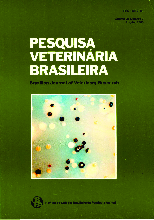 |
|
|
|
Year 2000 - Volume 20, Number 2
|

|
Experiments in rabbits with cyanogenic plants, 20(2):65-70
|
ABSTRACT.- Brito M.F., França T.N., Oliveira K.D. & Cerqueira V.D. 2000. [Experiments in rabbits with cyanogenic plants.] Estudos experimentais em coelhos com plantas cianogênicas. Pesquisa Veterinária Brasileira 20(2):65-70. Projeto Sanidade Animal Embrapa/UFRRJ, Km 47, Seropédica, RJ 23851-970, Brazil.
The dried leaves of Piptadenia macrocarpa Benth. 1 =Anadenanthera macrocarpa (Benth.) Brenan], Piptadenia viridiflora (Kunth.) Benth. and Holocalyx glaziovii Taub. [=Holocalyx balansae Micheli], all trees of the Leguminosae Mimosoideae family, were given orally to rabbits in single doses. In the case of H. glaziovii, leaves were fed after being stored in two diferente ways. In the first series of experiments, Piptadenia macrocarpa failed to poison rabbits although the leaves were collected when sprouting, the most toxic stage forcattle. The experiments were performed 4 to 6 months after the leaves had been collected and dried. In a second series of experiments, similar leaves were fed at monthly intervals after harvest. They were toxic for the first 5 months, but were innocuous after 6 months storage. In both series of experiments the leaves were dried in the shade and then kept in cotton sacks at room temperature. They always were milled at the occasion of the experiments. These experiments with rabbits confirm the results with cattle, in which severe poisoning was caused by leaves stored for 3 months but caused no ili effect after 4 months, even when fed in large amounts. Young leaves of P. viridiflora were lethal at 12 g/kg, 12 months after collection and drying. In a second experiment the lethal dose was only 6 g/kg with leaves stored for only 2 months. These results show that the dried leaves of these species lose toxicity with time. Holocalyx glaziovii leaves were milled 6 weeks after collecting and dried and stored in sealed containers. They were fed in. single doses to different rabbits at intervals during a whole year. Lethal doses were initially 0.75 g/kg to 1.5 g/kg but rose to 1.5 g/kg to 3 g/kg by the end of the year. In a second experiment, leaves stored in cotton sacks and milled just before feeding were compared with milled leaves stored in sealed glass containers. The plant material kept in cotton sacks had halfthe toxicity of the leaves stored.for 2 months in sealed containers. After 10 to 12 months it was only a little less toxic than that stored in the sealed containers but there were no differences after 14 months. The symptoms observed in the rabbits that were poisoned by the dried leaves of P. macrocarpa, P. viridiflora and H. glaziovii were neuromuscular. Post-mortem findings and histopathological findings were almost absent. On opening the stomach, a strong smell of bitter almonds was sometimes noticed. The degree of toxicity during the storage of the dried leaves of he three tested plants was generallywell correlated with the picrate testfor cyanide. |
| |
|
|
| |
|
 |